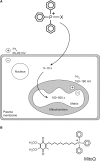Understanding and preventing mitochondrial oxidative damage
- PMID: 27911703
- PMCID: PMC5095902
- DOI: 10.1042/BST20160108
Understanding and preventing mitochondrial oxidative damage
Abstract
Mitochondrial oxidative damage has long been known to contribute to damage in conditions such as ischaemia-reperfusion (IR) injury in heart attack. Over the past years, we have developed a series of mitochondria-targeted compounds designed to ameliorate or determine how this damage occurs. I will outline some of this work, from MitoQ to the mitochondria-targeted S-nitrosating agent, called MitoSNO, that we showed was effective in preventing reactive oxygen species (ROS) formation in IR injury with therapeutic implications. In addition, the protection by this compound suggested that ROS production in IR injury was mainly coming from complex I. This led us to investigate the mechanism of the ROS production and using a metabolomic approach, we found that the ROS production in IR injury came from the accumulation of succinate during ischaemia that then drove mitochondrial ROS production by reverse electron transport at complex I during reperfusion. This surprising mechanism led us to develop further new therapeutic approaches to have an impact on the damage that mitochondrial ROS do in pathology and also to explore how mitochondrial ROS can act as redox signals. I will discuss how these approaches have led to a better understanding of mitochondrial oxidative damage in pathology and also to the development of new therapeutic strategies.
Keywords: ROS; mitochondria; oxidative damage.
© 2016 The Author(s).
Figures


References
-
- Murphy M.P. (2009) Mitochondria—a neglected drug target. Curr. Opin. Investig. Drugs 10, 1022–1024 PMID: - PubMed
Publication types
MeSH terms
Substances
Grants and funding
LinkOut - more resources
Full Text Sources
Other Literature Sources
Miscellaneous

